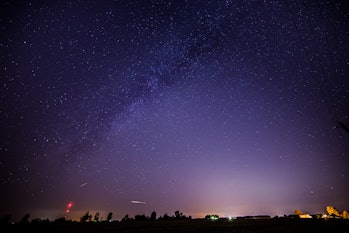The meteor shower will peak on Wednesday night.
Source: Inverse.com
Celestial objects come and go from view in the night sky. Whether it be the Full Moon, a meteor shower, or just the best night to see Mars, we’re here to direct your eyes skyward and tell you to look up and appreciate the wonders of space from Earth.
This week, we’re asking you to marvel at the beauty of the Draconid meteor shower, which will light up the night sky from October 6-8, peaking on Wednesday night.
The annual meteor shower takes place around the same time each year, as Earth crosses the orbital trail of Comet 21P/Giacobini-Zinner.
The small comet, stretching about 1.24 miles in diameter, orbits the Sun every six and a half years. The ice and rock debris that fall from the comet collide with Earth’s upper atmosphere when our planet crosses the comet’s path, resulting in the meteor shower.

While the Draconid meteor shower is consistent, it isn’t exactly a spectacle. The shower peaks at five meteors per hour, offering a humble light show in the night sky. But if the meteor shower’s peak happens to fall at the same time when its parent comet is the closest to the Sun, then the Draconid has been known to rain down hundreds and thousands of meteors per hour.
The last time that took place was in the year 2011, when spectators saw the Draconid shower rain down up to 600 meteors an hour.
The meteor shower is also convenient. Unlike other showers, you don’t have to stay up till late hours of the night to observe Draconid. Instead, the best viewing times is during the early evening hours, right after the Sun has set.
The Draconid shower is active from October 6 till October 10, and is expected to peak the night of October 7.
But Tuesday to Thursday night are all good viewing times for this cosmic light show.
If you live in a crowded city like New York, it is best to get as high up as possible in order to minimize light pollution. So going on a balcony or rooftop is highly recommended.
You also want to block out any light coming from screens of electronic devices or flashlights and allow your eyes to get accustomed to the darkness for around 30 minutes before you look up.
Source: Inverse.com

































Leave a Comment
You must be logged in to post a comment.